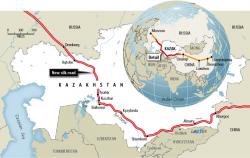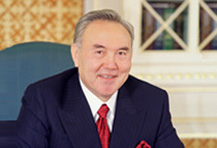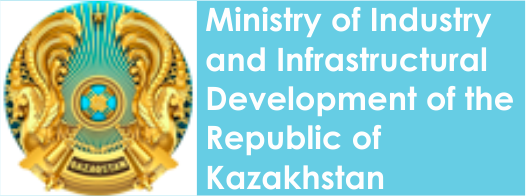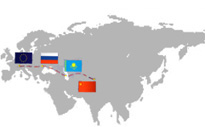
ARAL, Kazakhstan. A thousand years after the Silk Road began disappearing into the wind-blown steppe, the people of Kazakhstan are awaiting a modern, paved, high-speed version carrying 21st-century jewels such as jobs, indoor plumbing and connections to the global economy.
The new Silk Road is an ambitious $7 billion project to connect China with Western Europe along a 1,700-mile highway through Kazakhstan. Just as the ancient caravans transformed the world, bearing ideas and cultures along with their perfumes and spices, Kazakhstan is counting on the modern equivalent to stimulate economic growth that would have repercussions the world over, including in the United States.
It's not just pavement going from point A to B said Juan Miranda, director general of the Asian Development Bank's Central and West Asia Department . It's a Silk Road, leading to the creation of an economic corridor and stability, and I hope the road will benefit far more than Kazakhstan.
The job of laying pavement on shifting sands in the middle of an empty landscape is a monumental task, one that would have made even the mighty Genghis Khan flinch. But various international organizations have taken on manageable chunks, with the World Bank financing more than 625 miles, from Shymkent in the south to the northern border with Russia, lending $2.12 billion for the project. The ADB , the Islamic Development Bank , the Japan International Cooperation Agency and other institutions are working on segments elsewhere in Kazakhstan.
Completion of the Kazakh work planned for 2013 will mean completion of the entire highway. It will include existing or newly upgraded roads in China and Russia, which is already linked to Western Europe. Although there were many branches of the Silk Road in ancient times, this road follows the northern route, which passed through Kazakhstan.
Travel 300 miles of that route, from Kyzylorda a pleasant southern city of about 200,000 northward to the bereft town of Aralsk near the still-evaporating Aral Sea, and what is euphemistically called a highway fades from patches of blacktop to bone-jarring, hit-your-head-on-the-car-roof dirt and gravel. Only a camel could love it, and they do, with grazing herds visible along the long, flat horizon. Instead of conveniences, there is only the opposite: Finding a toilet means searching for an inconspicuous spot behind a sandy ridge.
The twisting, threatening route the road to perdition, Miranda says, laughing passes in sight of Baikonur, the Russian-leased space center where rockets thunder into the heavens and, on the surrounding landscape of Earth, solitary horsemen trot through tumbleweed as if to the rhythms of the nomadic past.
Where a Western traveler hurtling along the road perceives bleakness, Kazakhs see shining opportunity.
This road across the country will go through regions where half the population lives, said Abelgazy Kussainov, who, until a recent reshuffling of the cabinet, was Kazakhstan's transportation minister. It will have an enormous social effect, with cafes, hotels, businesses built along it. As cargo increases, new jobs will be created.
Already, the project employs 50,000 workers across the country, he said, and 40 big construction companies are involved, each of them feeding their workers the equivalent of one head of cattle every day. Even better, Kussainov said, Kazakhs are learning valuable road-building skills from foreign companies operating here. A day-long journey on the southwestern corridor takes a traveler past teams of surveyors and dozens upon dozens of Kazakhs at the controls of bulldozers and graders, molding the stubborn soil into a roadbed.
Miranda predicts the project eventually will increase travel speed by 40 percent, reduce freight-transport costs by half and, by 2020, boost Kazakhstan's gross domestic product 68 percent above the 2010 base line. A study a few years ago by the U.S. Chamber of Commerce found that if roads were improved and customs procedures at borders simplified, the route would be an attractive, efficient alternative to ocean transport.
Benefits for the U.S.
In China, the route begins at the Yellow Sea port of Lianyungang. From there it heads west to Zhengzhou, on the Yellow River, Lanzhou in north-central China and Urumqi in northwest China. It crosses into Kazakhstan at Khorgos, then Almaty, Shymkent, Kyzylorda, Aqtobe and on to Russia, near Orenburg, to reach roads leading to Moscow, St. Petersburg and beyond. It is a trip of more than 5,200 miles.
The United States has a natural interest in Central Asian transportation, not only because it carries supplies to Afghanistan but because of the potential to bring the region economic growth and integration with the wider world.
A recent Central Asia Study Group report concluded that diversifying transportation and infrastructure would make Central Asia less vulnerable to political pressure, to the benefit of the United States.
In the longer term, said Johannes F. Linn, a former World Bank vice president for Europe and Central Asia and now a Brookings Institution senior fellow, the U.S. is interested in a peaceful and prosperous Central Asia that doesn't become an extension of Afghanistan and its kind of troubles.
Still, Jacques Bure, senior highway engineer for the World Bank , cautioned that perfect ribbons of asphalt will not lead to promised growth if logistics remain unimproved, safety measures go unobserved and customs clearance at the border takes days instead of minutes.
Will you all of a sudden re-create that earlier glory he asked. This is a very important artery for Kazakhstan, and for the region, but it will take time. You have to go a step further to provide the trade and create the jobs.
A path for big dreams
The challenges have been daunting: moving more than 700 million cubic feet of material for this part of the road and housing workers in rudimentary metal shelters, erected in the shadow of the cement works strung along the road, for weeks on end with no movies, no place to go and the best diversion an occasional celebratory meal capped by boiled sheep's head. Favored diners are treated to a fatty, leathery portion near the eyes.
Last summer, when temperatures rose above 120 degrees, crews started at 6 a.m., stopped at 11 a.m. and worked again from 4 to 11 p.m.
The highway lies at the heart of a larger regional network envisioned by the 10-country Central Asia Regional Economic Cooperation program, coordinated by the ADB along with the World Bank, International Monetary Fund, U.N. Development Program and others. Through 2017, they are directing $20 billion toward railroads and highways reaching west to the Caspian and Black seas and south to Uzbekistan, Tajikistan and Afghanistan.
All of this has made even the most modest of Kazakh villages dream of a new life. In Koszhar several dozen mud-brick cottages on Lake Kambash near the Aral Sea villagers dare to imagine indoor plumbing and a paved village road.
A few rotting boats lie abandoned on the shore, where Turkbenuli Musabayev, the regional administrator, says a tourist mecca will rise, with campgrounds and a five-star hotel. Now the closest lodging is 50 miles away in Aralsk, where the top floor of the hotel is boarded up, hot water is unpredictable, the bathrooms are furnished with ancient toilets and a strange mutation of either a large sink or a very small, high bathtub, and the manager must be consulted before toilet paper can be distributed.
Come back here in 1 1 / 2 years and you 'll see a big difference, Musabayev promises. We 'll have another emirate. The climate and topography are the same: land and sand. Why not?
We could organize fishing and hunting with falcons. The Arabs ... those guys really like that kind of thing.



















